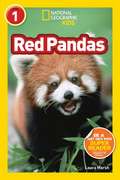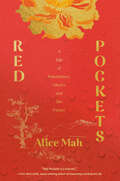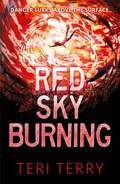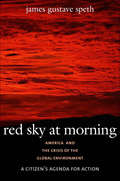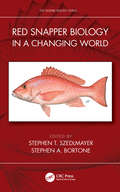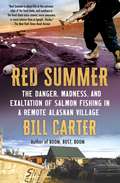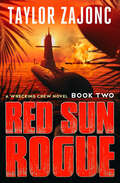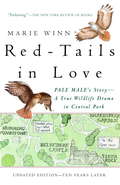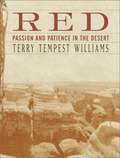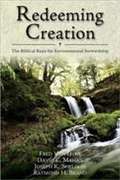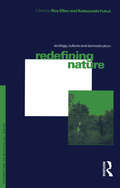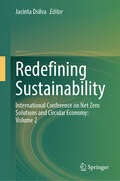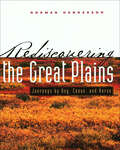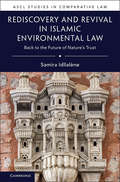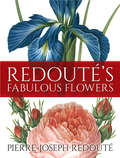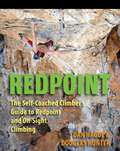- Table View
- List View
Red Pandas (National Geographic Kids Readers #Level 1)
by Laura Marsh National Geographic Kids StaffFind out about the shy and rarely seen red panda! This level 1 reader documents the lives of red pandas in their environment. <P><P>The carefully constructed text and beautiful photographs guarantee a successful and rewarding reading experience for any reader, especially those who love wild animals.
Red Pandas: A Natural History
by Dorcas MacclintockDescribes the physical characteristics, habitat, behavior, and life cycle of the small long-tailed red panda of Asia.
Red Pockets: A Tale of Inheritance, Ghosts and the Future
by Alice MahSHORTLISTED FOR THE 2025 WAINWRIGHT PRIZE FOR CONSERVATION WRITINGA poignant personal narrative about family, cultural history, and ecology, and a quest to understand what we owe our ancestors and our descendants from an unforgettable new voice."Part of me knew what the hungry ghosts wanted all along, what they still want. It is not vengeance. No, they want something else, but we refuse to listen. They want us to face up to our broken obligations." Every spring during the Qingming Festival, people return to their home villages in China to sweep the tombs of their ancestors. They make offerings of food and incense to prevent their ancestors from becoming hungry ghosts that could cause misfortune, illnesses and crop failures. Yet for the past century, the tombs of many overseas Chinese have been left unattended because of the ruptures of war and revolution. Following a record year of wildfires, Alice Mah returns to her family's rice village in South China, ninety years after her grandfather's last visit and fifty years after her last relative died in the village. While she finds clan members who still remember her family, there are no tombs left to sweep. Instead, there are incalculable clan debts to be paid. In Red Pockets, Mah chronicles her journey from the rice villages of South China to her home in post-industrial England, through the Chinatowns of Western Canada where she grew up, to the isles and industry of Scotland where she now lives. As years pass and fires rage on, she becomes increasingly troubled by her ancestors' neglected graves. Her research on pollution gives way to growing eco-anxiety, culminating in a crisis of spiritual belief. A haunting blend of memoir, cultural history and environmental exploration, Red Pockets confronts the hungry ghosts of our neglected ancestors, while searching for an acceptable offering. What do we owe to past and future generations? What do we owe to the places that we inhabit?
Red Sanders: Silviculture and Conservation
by T. Pullaiah S. Balasubramanya M. AnuradhaPterocarpus santalinus L.f., popularly known as Red Sanders, an endemic tree, belonging to the family Fabaceae is confined to the southern parts of Eastern Ghats. IUCN has listed this tree as endangered. The plant has superlative characteristics in its wood and has many medicinal properties. This plant has attracted the attention of both foresters and lay man because of its high valued wood which is being illegally harvested creating law and order problem. This book is a comprehensive monograph on Red Sanders and is divided into 15 chapters. The book provides information on taxonomy, morphology, distribution, wood anatomy, wood properties and uses, dye principle, phytochemistry, pharmacology, Silvicultural aspects, propagation, cultivation practices, reproductive biology, pests and diseases, biotechnology, molecular studies, conservation, trade, commerce, socioeconomic aspects of Red Sanders, and grey areas of research. The book is profusely illustrated with colour photographs and line drawings. Relevant references have been provided under each chapter. This monograph on Red Sanders with systematic representation of information and illustrations will be a desk reference and field guide to foresters, botanists, researchers, farmers, traders and environmentalists.
Red Sky Burning
by Teri TerryWhere do you run when there's no one left to trust? The stunning follow up to DARK BLUE RISING, the new thriller trilogy from Teri Terry.She survived the hurricane and now Tabby is on the run, hoping she can make it to her old friend Jago before her pursuers catch her. All she has are questions, about the experiments she saw in the basement of her swim school...about who - or what -she is.Denzi is also searching for answers after the storm. But each time he connects with a survivor, they disappear.The environmental activist group The Circle claims responsibility for the hurricane that destroyed Tabby and Denzi's school and caused great damage around the world. Now they threaten further terror if their demands aren't met. As the political tension bubbles over into violence, Tabby and Denzi search for the truth. There's something connecting them, drawing their paths into one. Can they put the puzzle pieces together and discover what The Circle wants with them? Sometimes it's better not to know the truth...
Red Sky Burning
by Teri TerryWhere do you run when there's no one left to trust? The stunning follow up to DARK BLUE RISING, the new thriller trilogy from Teri Terry.She survived the hurricane and now Tabby is on the run, hoping she can make it to her old friend Jago before her pursuers catch her. All she has are questions, about the experiments she saw in the basement of her swim school...about who - or what -she is.Denzi is also searching for answers after the storm. But each time he connects with a survivor, they disappear.The environmental activist group The Circle claims responsibility for the hurricane that destroyed Tabby and Denzi's school and caused great damage around the world. Now they threaten further terror if their demands aren't met. As the political tension bubbles over into violence, Tabby and Denzi search for the truth. There's something connecting them, drawing their paths into one. Can they put the puzzle pieces together and discover what The Circle wants with them? Sometimes it's better not to know the truth...
Red Sky at Morning: America and the Crisis of the Global Environment
by James Gustave SpethThis book will change the way we understand the future of our planet. It is both alarming and hopeful. James Gustave Speth, renowned as a visionary environmentalist leader, warns that in spite of all the international negotiations and agreements of the past two decades, efforts to protect Earth's environment are not succeeding. Still, he says, the challenges are not insurmountable. He offers comprehensive, viable new strategies for dealing with environmental threats around the world. The author explains why current approaches to critical global environmental problems-climate change, biodiversity loss, deterioration of marine environments, deforestation, water shortages, and others-don't work. He offers intriguing insights into why we have been able to address domestic environmental threats with some success while largely failing at the international level. Setting forth eight specific steps to a sustainable future, Speth convincingly argues that dramatically different government and citizen action are now urgent. If ever a book could be described as "essential," this is it.
Red Sky at Night
by Elly MacKayA memorable collection of weather sayings, beautifully arranged in story form and illustrated by renowned paper artist Elly MacKay.Red sky at night, sailor's delight. And, the next morning, when the dew is on the grass, no rain will come to pass. These are the perfect conditions for a grandfather to take his grandchildren out on a fishing trip. Especially since, as the saying goes, when the wind is from the West, then the fishes bite the best. The family takes a boat out on the lake, fishing and swimming and eventually camping out on a nearby island, taking full advantage of the gorgeous weather. But the next day . . . red sky in the morning, sailors take warning! The family ventures back home just in time to avoid a rainstorm. But not to worry -- the more rain, the more rest. Fair weather's not always best.Acclaimed paper artist Elly MacKay illustrates a lovely family narrative through the use of weather aphorisms, creating a beautiful and informational story which will appeal to children's timeless fascination with the natural world.
Red Snapper Biology in a Changing World (CRC Marine Biology Series)
by Stephen T. Szedlmayer Stephen A. BortoneRed Snapper Lutjanus campechanus, is an important commercial and recreational fish species and there has been much interest in maintaining its status among a variety of scientific, social and economic levels. Stocks are influenced by varying environmental conditions, changing fishing effort and efficiency, anthropogenic effects, inter- and intraspecific interactions, bycatch from other fisheries, and habitat alterations. Red Snapper Biology in a Changing World explores these changing factors and their potential effects on Red Snapper in the Eastern Atlantic region including the Gulf of Mexico and Southeastern U.S. The book will provide a better understanding of Red Snapper population fluctuations that will subsequently allow for better management decisions and more informed user groups in their efforts to maintain a sustainable fishery. It explores the responses Red Snapper have made, and are making, relative to their life history attributes such as early life history and adult ecology, especially attributes associated with population distribution and abundance, movement patterns, fish health issues and management success. A compendium of many papers presented at the 147th annual meeting of the American Fisheries Society in Tampa, Florida, this volume also includes additional research completed as a result of the symposium. It will be essential reading for fisheries scientists and managers, ichthyologists, resource and environmental managers, and policymakers who are involved with coastal fisheries.
Red Summer: The Danger, Madness, and Exaltation of Salmon Fishing in a Remote Alaskan Village
by Bill CarterA vivid, unforgettable account of the danger, pain, and joy of working on a salmon fishing boat and living in a small village on the farthest edge of Alaska Set in the tiny Native village of Egegik on the shores of Alaska's Bristol Bay, Bill Carter's Red Summer is the thrilling story of one man's journey from novice to seasoned fisherman over the course of four beautiful, brutal summers in one of the earth's few remaining wild places. As millions of salmon race toward their annual spawning grounds, Carter learns the ancient, backbreaking trade of the set net fisherman, one of the most exhilarating and dangerous jobs in the world. Housed in a dilapidated shack with no hot water and boarded-up windows that keep the bears at bay, Carter spends his days battling the elements on the river and his nights drinking whiskey with a memorable group of hardworking, hard-living characters. There's Sharon, the tough, charismatic woman who runs Carter's fishing crew; Carl, her stoic but warmhearted colleague; and a half-dozen local fishermen, many born and raised in this unforgiving place. Their stories -- harrowing, touching, full of humor -- all underscore the credo of the village's fishermen: Do the work or leave. Carter's crew is imperiled a number of times as tides rise, nets are snagged, and the weight of too many fish threatens to sink their boat. Written with gusto and honesty, Red Summer brims with astonishing human experience and joins the grand tradition of books written by great American outdoorsmen-writers such as Ernest Hemingway, Edward Abbey, Peter Matthiessen, and Sebastian Junger. Red Summer will appeal not only to fishermen, naturalists, adventurers, and armchair anthropologists alike but also to anyone who has ever yearned, however privately, to escape the bonds of modern civilization.
Red Sun Rogue (The Wrecking Crew Novels)
by Taylor ZajoncAs an unknown enemy wreaks havoc in the South China Sea, a renegade submarine captain untangles a deadly conspiracy rooted in lost WWII technology. Salvage diver–turned–submarine captain Jonah Blackwell and his crew are on a covert mission of mercy, spiriting refugees out of North Korea as a hundred-year winter ravages the Pacific. Hunted by the Japanese fleet and forced to surrender, Jonah and his crew must race against time in an adventure spanning the irradiated waters of Fukushima, flood-beset Tokyo, and the crumbling tropical remains of a secret research facility. At the center of it all is an enigmatic Japanese technology cult with roots in the clandestine weapons program of the Second World War—a cult that has waited seventy years to strike its final blow.
Red Wolves and Black Bears
by Edward Coolbaugh HoaglandThe life and times of Johnny Appleseed. The adventures of New York City tugboatmen. Street life in Cairo and Dar es Salaam. The pains and paradoxes of being male and female; the dilemmas of an aging America; the unease of writers between books. The natural history of swallows, juneberries, owls, foxes, and toads. The fourteen essays in this brilliant collection cover all of the above and much more.
Red-Tails in Love
by Marie WinnMarie Winn is our guide into a secret world, a true wilderness in the heart of a city. The scene is New York's Central Park, but the rich natural history that emerges here--the loons, raccoons, woodpeckers, owls, and hundreds of visiting songbirds--will appeal to wildlife lovers everywhere. At its heart is the saga of the Fifth Avenue hawks, which begins as a love story and develops into a full-fledged mystery.At the outset of our journey we meet the Regulars, a small band of nature lovers who devote themselves to the park and its wildlife. As they watch Pale Male, a remarkable young red-tailed hawk, woo and win his first mate, they are soon transformed into addicted hawk-watchers. From a bench at the park's model-boat pond they observe the hawks building a nest in an astonishing spot--a high ledge of a Fifth Avenue building three floors above Mary Tyler Moore's apartment and across the street from Woody Allen's.The drama of the Fifth Avenue hawks--hunting, courting, mating, and striving against great odds to raise a family in their unprecedented nest site--is alternately hilarious and heartbreaking. Red-Tails in Love will delight and inspire readers for years to come.From the Hardcover edition.
Red: Passion and Patience in the Desert
by Terry Tempest Williams"It is a simple equation," writes Terry Tempest Williams, "place + people = politics." Nowhere is this more apparent than in the American West, where millions of acres of wilderness are at stake in the redrock desert of southern Utah. "How are we to find our way toward conversation?" she asks. One story at a time. Red traces Williams's lifelong love of and commitment to the desert, as she explores what draws us to a place and keeps us there. It brings together the lyrical evocations of Coyote's Canyon and Desert Quartet with new essays of great power and originality, essays that range from a family discussion on the desert tortoise to an investigation of slowness to startling encounters with Anasazi artifacts (including a ceremonial sash made of scarlet macaw feathers). Pursuing the question of why America's redrock wilderness matters to the soul of this country, Red bridges the divide between the political and the poetic and shows how this harshest and most fragile of landscapes inspires a soulful return to "wild mercy." The preservation of wildness is not simply a political process but a spiritual one. With grace, humor, and the subtleties of her perception, Williams reminds us of what we have forgotten in the chaos of our lives and what can be reclaimed in the stillness of the desert. Red is further proof that the writings of Terry Tempest Williams possess a revelatory power and an emotional intelligence at once rare and authentic.
Redeeming Creation: The Biblical Basis for Environmental Stewardship
by Fred Vandyke; David C. Mahan; Joseph K. Sheldon; Raymond H. BrandCombining compelling stories with both biblical and scientific investigation, Redeeming Creation addresses the ecological crisis we face today. Population Explosion, Rain forests stripped bare, Destruction of animal habitat, The death of entire species, Depletion of the ozone layer, Global warming.
Redeeming REDD: Policies, Incentives and Social Feasibility for Avoided Deforestation
by Michael I. BrownIt is now well accepted that deforestation is a key source of greenhouse gas emissions and of climate change, with forests representing major sinks for carbon. As a result, public and private initiatives for reducing emissions from deforestation and forest degradation (REDD) have been widely endorsed by policy-makers. A key issue is the feasibility of carbon trading or other incentives to encourage land-owners and indigenous people, particularly in developing tropical countries, to conserve forests, rather than to cut them down for agricultural or other development purposes. This book presents a major critique of the aims and policies of REDD as currently structured, particularly in terms of their social feasibility. It is shown how the claims to be able to reduce greenhouse gas emissions as well as enhance people's livelihoods and biodiversity conservation are unrealistic. There is a naive assumption that technical or economic fixes are sufficient for success. However, the social and governance aspects of REDD, and its enhanced version known as REDD+, are shown to be implausible. Instead to enhance REDD's prospects, the author provides a roadmap for developing a new social contract that puts people first.
Redefining Nature: Ecology, Culture and Domestication (Explorations In Anthropology Ser.)
by Roy EllenHow can anthropology improve our understanding of the interrelationship between nature and culture?- What can anthropology contribute to practical debates which depend on particular definitions of nature, such as that concerning sustainable development?Humankind has evolved over several million years by living in and utilizing 'nature' and by assimilating it into 'culture'. Indeed, the technological and cultural advancement of the species has been widely acknowledged to rest upon human domination and control of nature. Yet, by the 1960s, the idea of culture in confrontation with nature was being challenged by science, philosophy and the environmental movement. Anthropology is increasingly concerned with such issues as they become more urgent for humankind as a whole. This important book reviews the current state of the concepts of 'nature' we use, both as scientific devices and ideological constructs, and is organised around three themes:- nature as a cultural construction;- the cultural management of the environment; and- relations between plants, animals and humans.
Redefining Sustainability: International Conference on Net Zero Solutions and Circular Economy: Volume 2
by Jacinta DsilvaThe second volume of the book ‘Proceedings of International Conference on Net Zero Solutions and Circular Economy’ shifts focus to the human and technological elements of sustainability, examining the roles of leadership, social impact, circular economy principles, and education. Sustainable leadership is key in directing the systemic changes needed for a low-carbon, equitable future. The volume further explores how visionary leaders can foster sustainability in organizations and communities. It also dives deep into the circular economy, a transformative concept aimed at minimizing waste and making full use of resources, presenting strategies for transitioning from linear to circular models in various industries. In addition to leadership and economic models, this volume emphasizes the critical role of education in embedding sustainability into the next generation's mindset, while highlighting how technology acts as a powerful enabler of these solutions. Smart cities, digital innovation, and clean technology are explored as tools that can advance the sustainability agenda, providing new approaches to energy, mobility, and resource management. Similar to volume I, there are practical discussions, case studies and recommendations from academia, business and other stakeholders.
Redefining the Agenda for Social Justice: Voices from Europe and Asia
by Meena Menon Francine MestrumThe book relates three years of history of social movements from Asia and Europe who work on social justice, as a rough overview. The work for the book is mainly done on the ground, day after day, working in villages and cities, with people and their organisations, organising resistance and preparing alternatives. It is based on the fact that European and Asian concerns are identical, in spite of divergent levels of development and wealth, and that the existing international initiatives, such as the ILO’s social protection floors, or the UN’s Sustainable Development Goals are perfectly compatible with neoliberal policies.The book goes beyond and sees social commons as a strategic tool for transforming societies. It is basically a project for the sustainability of life, of humans, of societies, and of nature. The book describes the ideas at the basis of the work in different sectors. It is not about the practice of social policies but about the ideas and discourses that can in the end shape the political practices. In sum, this book, presents a new social paradigm. It concretely shows how social justice and environmental justice do go hand in hand.
Rediscovering the Great Plains: Journeys by Dog, Canoe, and Horse (Creating the North American Landscape)
by Norman Scott HendersonAn &“engrossing&” memoir of traveling Canada's Qu&’Appelle River Valley via horse, canoe, and Native American dogsled (Calgary Herald). The North American Plains are one of the world&’s great landscapes—but today, the most intimate experience most of us are likely to have of the great grasslands is from behind the window of a car or train. It was not always so. In the earliest days, Plains Indians traveled on foot across the vastness, with only the fierce, wolflike Plains dogs as companions. Later, with the arrival of Europeans, horses and canoes appeared on the Plains. In this book, Norman Henderson, a leading scholar of the world&’s great temperate grasslands, revives these traditional modes of travel, journeying along 200 miles of Canada&’s Qu&’Appelle River valley by dog and travois (the wooden rack pulled by dogs and horses used by Native Americans to transport goods), then by canoe, and finally by horse and travois. Henderson interweaves his own adventures with the exploits of earlier Plains travelers, like Lewis and Clark, Francisco Coronado, La Vérendrye, and Alexander Henry. Lesser-known experiences of the fur traders and others who struggled to cross this strange and forbidding landscape also illuminate the story, while Henderson&’s often humorous description of his attempts to find and train old Plains breeds of dogs and horses highlight the difficulties involved in recreating archaic travel methods. He also draws on the history of the world&’s other great temperate grasslands: the South American pampas and the Eurasian steppes. Recalling the work of Ian Frazier and Jonathan Raban, Henderson&’s account offers a deeper understanding of the natural and human history of the North American Plains. &“A captivating &‘biography of a landscape,&’ its good humor blended with impressive scholarship, including snappy thumbnail histories of canoes, horses, dogs, barbed wire and those pesky blood-sucking mosquitoes.&” —Publishers Weekly
Rediscovery and Revival in Islamic Environmental Law: Back to the Future of Nature's Trust (ASCL Studies in Comparative Law)
by Samira IdllalèneThe common ground between religions could be fruitfully promoted in order to call for an effective protection of the climate system. Positioned at a junction of different worlds, this book is a multidisciplinary work on Islamic law, common law and environmental law. Looking at the past, present and future, the author suggests a paradigm shift starting from the common ground in order to propose a better future for environmental law in Muslim countries. As the first book to compare Shari'a and common law in field of environmental protection, it suggests a new path in comparative environmental law by recognizing the contributions of both history and spirituality.
Rediscovery of North America (Clark Lectures #Vol. 1990)
by Barry LopezFive hundred years ago an Italian whose name, translated into English, meant Christopher Dove, came to America and began a process not of discovery, but incursion -- "a ruthless, angry search for wealth" that continues to the present day. This provocative and superbly written book gives a true assessment of Columbus's legacy while taking the first steps toward its redemption. Even as he draws a direct line between the atrocities of Spanish conquistadors and the ongoing pillage of our lands and waters, Barry Lopez challenges us to adopt an ethic that will make further depredations impossible. The Rediscovery of North America is a ringingly persuasive call for us, at long last, to make this country our home.From the Trade Paperback edition.
Redouté's Fabulous Flowers
by Pierre-Joseph RedoutéPierre-Joseph Redouté (1759–1840) ranks among the most highly regarded botanical illustrators in history. Known as the "Raphael of Flowers" for his meticulously accurate watercolors of roses, lilies, and other flowers, Redouté dominated botanical art from 1790 to 1830. The official court artist for Louis XVI and art tutor to Marie Antoinette, he survived the Terror and received the patronage of Napoleon's wife, Empress Josephine.Today the appreciation of Redouté's masterworks is no longer limited to aristocratic circles. Hailed by botanists for their scientific accuracy and by lovers of fine art for their peerless beauty, the artist's floral illustrations appear in reproductions in millions of homes around the world. This original compilation presents 80 exquisite renderings of his finest works, with each image accompanied by a brief caption. In addition to its value as a reference for artists, this lushly illustrated volume is a wonderful companion for nature lovers.
Redpoint
by Douglas Hunter Dan HagueThe first in-depth book on redpointing, where the climber does not weight the rope or pull or stand on manmade equipment.
